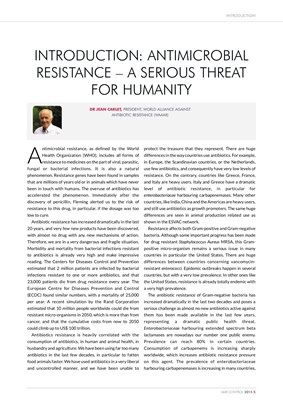
INTRODUCTION
AMR CONTROL 2015 5
A
ntimicrobial resistance, as defined by the World
Health Organization (WHO), includes all forms of
resistance to medicines on the part of viral, parasitic,
fungal or bacterial infections. It is also a natural
phenomenon. Resistance genes have been found in samples
that are millions of years old or in animals which have never
been in touch with humans. The overuse of antibiotics has
accelerated the phenomenon. Immediately after the
discovery of penicillin, Fleming alerted us to the risk of
resistance to this drug, in particular, if the dosage was too
low to cure.
Antibiotic resistance has increased dramatically in the last
20 years, and very few new products have been discovered,
with almost no drug with any new mechanisms of action.
Therefore, we are in a very dangerous and fragile situation.
Morbidity and mortality from bacterial infections resistant
to antibiotics is already very high and make impressive
reading. The Centers for Diseases Control and Prevention
estimated that 2 million patients are infected by bacterial
infections resistant to one or more antibiotics, and that
23,000 patients die from drug resistance every year. The
European Centre for Diseases Prevention and Control
(ECDC) found similar numbers, with a mortality of 25,000
per year. A recent simulation by the Rand Corporation
estimated that 10 million people worldwide could die from
resistant micro-organisms in 2050, which is more than from
cancer, and that the cumulative costs from now to 2050
could climb up to US$ 100 trillion.
Antibiotics resistance is heavily correlated with the
consumption of antibiotics, in human and animal health, in
husbandry and agriculture. We have been using far too many
antibiotics in the last few decades, in particular to fatten
food animals faster. We have used antibiotics in a very liberal
and uncontrolled manner, and we have been unable to
protect the treasure that they represent. There are huge
differences in the way countries use antibiotics. For example,
in Europe, the Scandinavian countries, or the Netherlands,
use few antibiotics, and consequently have very low levels of
resistance. On the contrary, countries like Greece, France,
and Italy are heavy users. Italy and Greece have a dramatic
level of antibiotic resistance, in particular for
enterobacteriacae harbouring carbapenemases. Many other
countries, like India, China and the Americas are heavy users,
and still use antibiotics as growth promoters. The same huge
differences are seen in animal production related use as
shown in the ESVAC network.
Resistance affects both Gram-positive and Gram-negative
bacteria. Although some important progress has been made
for drug resistant Staphylococcus Aureus MRSA, this Grampositive
micro-organism remains a serious issue in many
countries in particular the United States. There are huge
differences between countries concerning vancomycinresistant
enterococci. Epidemic outbreaks happen in several
countries, but with a very low prevalence. In other ones like
the United States, resistance is already totally endemic with
a very high prevalence.
The antibiotic resistance of Gram-negative bacteria has
increased dramatically in the last two decades and poses a
serious challenge as almost no new antibiotics active against
them has been made available in the last few years,
representing a dramatic public health threat.
Enterobacteriaceae harbouring extended spectrum beta
lactamases are nowadays our number one public enemy.
Prevalence can reach 80% in certain countries.
Consumption of carbapenems is increasing sharply
worldwide, which increases antibiotic resistance pressure
on this agent. The prevalence of enterobacteriaceae
harbouring carbapenemases is increasing in many countries,
INTRODUCTION: ANTIMICROBIAL
RESISTANCE - A SERIOUS THREAT
FOR HUMANITY
DR JEAN CARLET, PRESIDENT, WORLD ALLIANCE AGAINST
ANTIBIOTIC RESISTANCE (WAAAR)